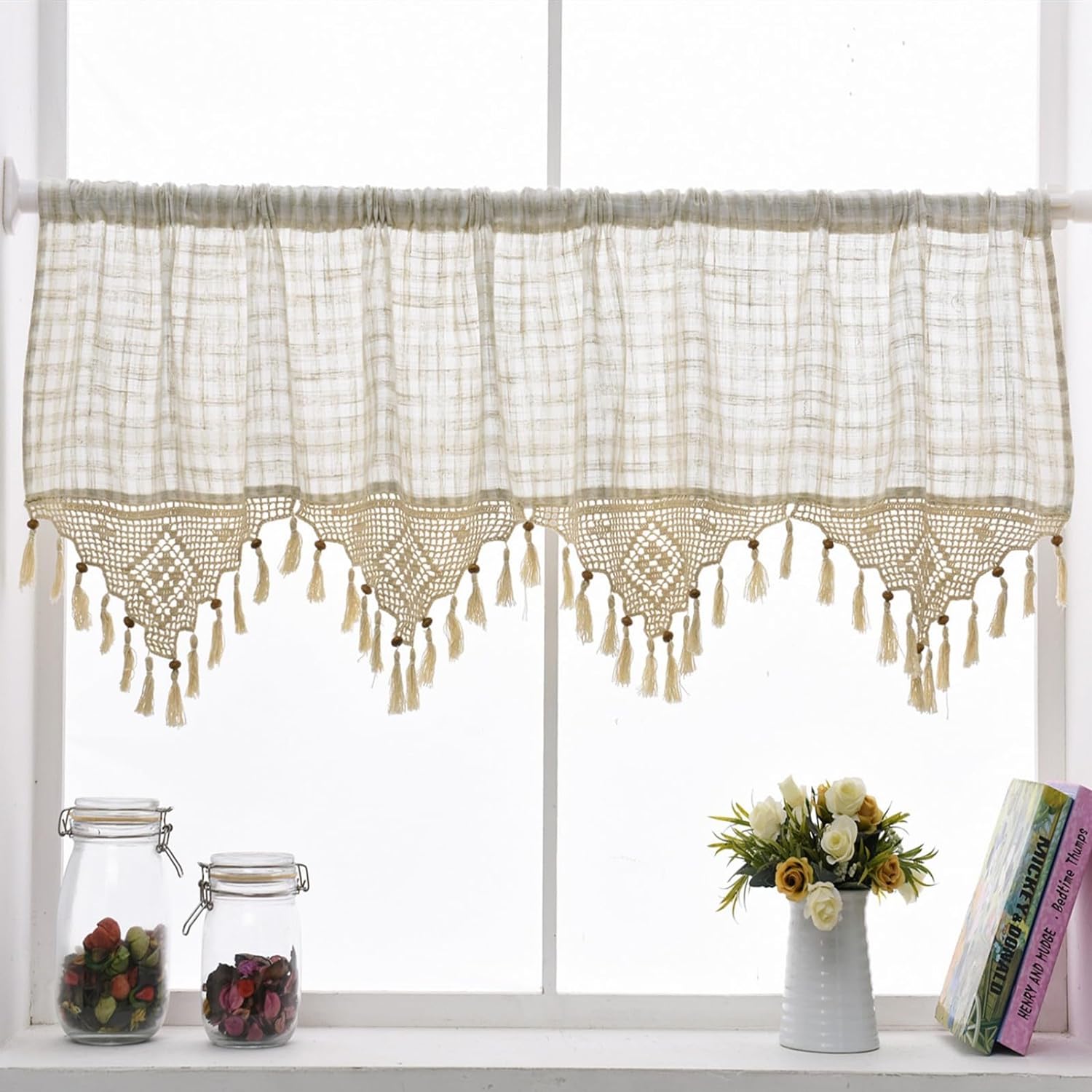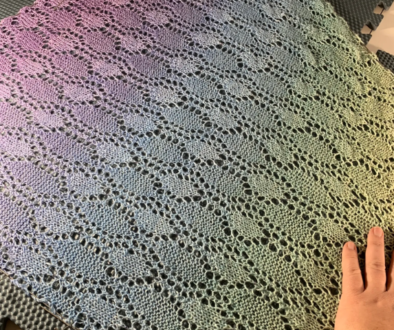Discover all you need to know about Crochet Curtains
Last Updated on January 7, 2024
Different Crochet Curtain Styles You’ll Fall in Love With
Thinking of getting crochet curtains to style your home? You’ve come to the right place. Crochet curtains have been a long-time favorite amongst home interior enthusiasts. The eloquent and regal look of these curtains cannot be compared to other curtains. A certain number of people take up crochet as a hobby and make decoration items, mats, shawls, and curtains to give their home a lovely handmade touch.
You can find a wide variety in them. These can be made in different colors but they are most popularly found in white. Some curtains have crochet edging that gives a beautiful finished look to your window treatment.
Even these handmade curtains have different styles, designs, and types. Let’s have a look at some different curtains in crochet. For the complete range, please visit our shop.
Boho Style Curtains for an Exquisite Look
If you want your home to stand out among the others and depict your unique sense of style then opting for boho crochet curtains would be a good choice. The boho look is typically inspired by the 1970’s design that includes colorful or white, layered textures with a casual yet collected feel within a room.
Check Price on Amazon
Check Price on Amazon
Cotton Crochet Curtains for Simple Elegance
The simple embroidered curtains with crochet in between can be put up anywhere in the house, especially giving rooms. They can match any theme color and go in any season all year round. Especially with the coming fall season, these will enhance the yellow ad orange hues in your home and give a cozy feeling.
Just like this beautiful curtain has embroidery in the center of it and also the edges of the curtain are decorated with crochet lace, giving a royal look.
Check Price on Amazon
Check Price on Amazon
Crochet Lace Curtains for a Vintage Look
Last but not least we have crochet lace curtains that are forever favorites. Lace looks good anywhere at any time of the year. You can find laces ade with crochet that is slightly different than machine made lace. The pattern of crochet lace will give a unique look to your window.
Check Price on Amazon
Check Price on Amazon
There is another type of crochet quite popular among the masses, known as macrame crochet. Macrame itself is quite popular in home decor making while crochet is mostly used in clothing designs. The only difference between the two is that macrame requires no use of tools or needles while crochet is done using tools i.e. two needles. Combining the two techniques we get beautiful wall dcor and window hangings that look beauifutil hanging in rooms around the house.
Check Price on Amazon
With the help of the internet, you can now get free crochet curtain patterns to easily make beautiful curtains on your own. Or you can read our post on where to find free patterns here.
You can find plenty of places where you can get crochet curtains for sale, but we try to bring you the best variety available. These have been in trend for a long time and will stay so for a long time to come too.
Amazing Crochet Curtains Patterns
Enhance the ambiance of your home decor with our stunning collection of “Amazing Crochet Curtain Patterns”. Our patterns are not only expertly designed but also easy to follow, even for beginners. These curtains are sure to add an element of elegance to any room. Choose from a variety of beautiful designs and make your home look both stylish and cozy. Try our patterns today and see the difference for yourself!
Crochet curtains are a beautiful addition to any home decor. They add a touch of elegance and warmth to any room. Crochet curtains come in a variety of styles and designs, from simple and classic to intricate and detailed patterns.
One of the benefits of crochet curtains is that they are versatile and can be used in any room of the house. They can be used in the living room, dining room, bedroom, or even in the kitchen. Crochet curtains can be made from a variety of materials, such as cotton, wool, or silk, depending on the desired look and feel.
We’ve listed here some of the best and most beautiful free crochet curtain patterns so you can make your home more beautiful. Or if you just like the look of crochet curtains but are not into making them yourself then simply visit our shop here.
Here are a few of the crochet curtain patterns available for free.
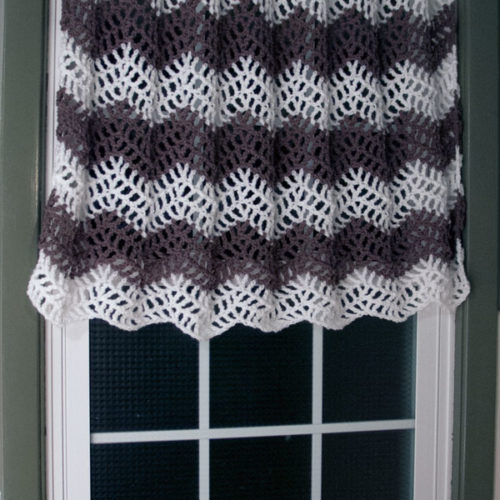
The ever-famous Chevron pattern looks good on any window made in crochet. Moogly has given a beautiful pattern for both long and short curtains. Made with a US-K, 6.5mm hook, you can easily follow the pattern and technique described in detail by Moogly and make this curtain easily.
The design shown can be worked in an alternating color pattern or even using a single color, it depends on your preference and decor.
You can find this Big Bold Chevron Crochet Curtain pattern here on Moogly.
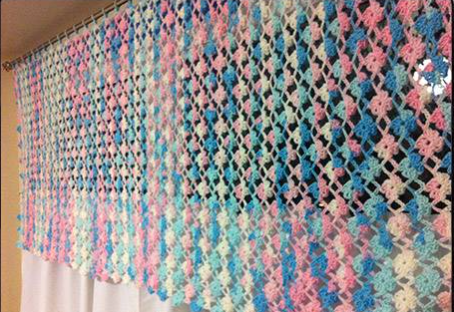
A crocheted floral lattice curtain looks good hung up in any room. This variegated yarn floral lattice valance creates a cheery and fun atmosphere. You can opt for a single color or go for the multi-colored version, that’s all up to you. But making this design is within easy reach if you follow the pattern given here by Dearest Debi.
Flower Power Crochet Valence
Floral patterns look gorgeous in crochet. We’ve picked another floral crochet valance pattern for you with bigger flowers. The flowers cascade the edges of the window. The size and colors of the flowers make it the center of attention in any room. This step-by-step tutorial will allow you to have some fun making this pattern and at the same time make your home look oh-so-pretty.
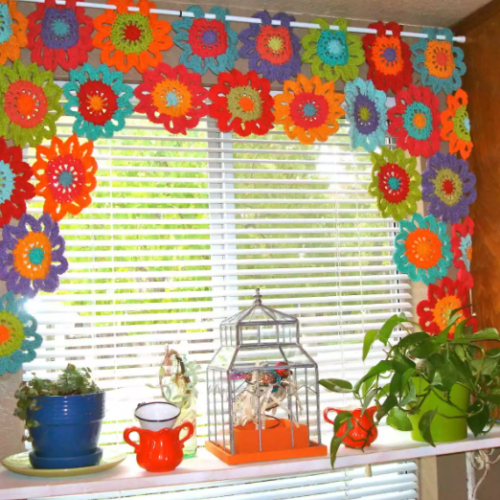

Next up we have the classic daisy crochet valance pattern in white and yellow that will let you enjoy the changing weather and beauty outside when you put them up in your window or your front door.
This crochet curtain pattern is designed to make a 14 x 45 inches valance, which you can adjust according to your window size. The detailed step-by-step instructions will guide you on how to make this beautiful pattern for your home.

If you want a simpler vintage-looking style, then this crochet pattern is just the one for you. Ravelry , a social networking website that brings together yarn artists and knitting/crocheting resources onto one platform, has many free crochet curtain patterns available to help you get started crocheting. This vintage crochet curtain pattern is one of them.
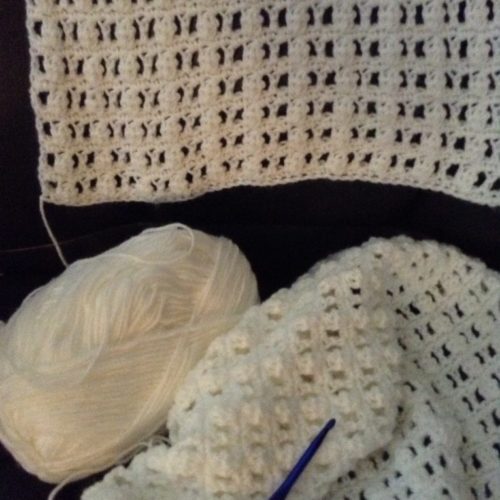
This design works best for any flat design like shawls, scarf, blankets, throw, etc. Multiple panels can be made for a blanket or shawl in different colors. The crochet cluster stitch gives a beautiful look to the curtain. Follow this tutorial here.
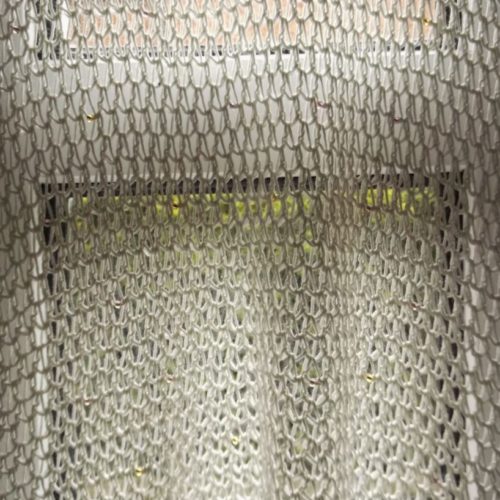
You’ll love this pattern design if you want to add a little glamour to your crochet curtains. Inserting beads in between the stitches creates a pazazz that you’re bound to love. Using a stitch pattern (or also called linen stitch, granite stitch, grit stitch), you can easily follow this pattern to create a subtle and airy curtain for your home.
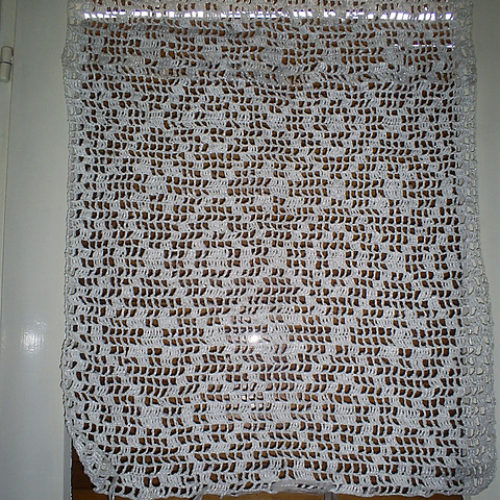
This crochet curtain pattern is just like any other pattern. You can make this up with yarn too, but Vera Grguricin has posted this pattern on Ravelry made with plarn. (Plastic + yarn = Plarn). Not only do you get a beautiful crochet curtain for your home but you also get to play your part in saving the environment. Have a look at this pattern here.
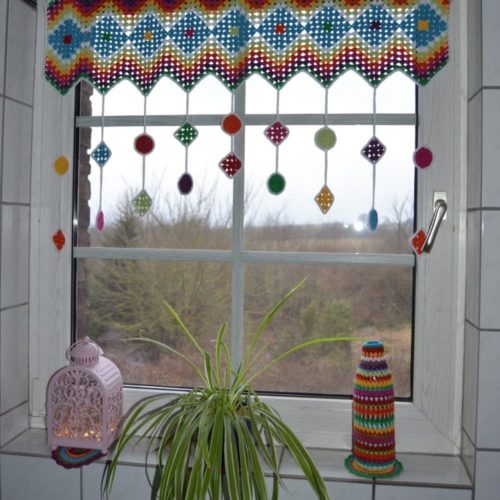
The pattern and colors of this crochet curtain by Marie Luciennewill look fun in any room of the house. She has given a complete and thorough step-by-step tutorial along with detailed pictures which makes it easy even for beginners to follow and replicate.
For all crochet crafters, these curtains will bring joy to make them for their homes or as a gift for their loved ones. Something handmade definitely enhances the beauty of your home. We hope you’ve found a pattern to dive right into. Happy Crocheting!
Crochet Curtains most common FAQs
1. Why is Crochet So Bulky?
Have you ever dreamt of wearing a crocheted sweater you could use as a life raft? Don’t worry, you’re not alone! While some crochet projects pack a punch in the cozy department, others can leave you feeling like you’re wearing a wearable cloud. But before you banish your yarn stash under the bed, let’s unravel the mystery of bulk in crochet!
Firstly, remember that “bulky” isn’t inherently a bad thing. Chunky scarves and cuddly amigurumi toys wouldn’t exist without it! But if you’re aiming for a more delicate drape or streamlined silhouette, understanding what contributes to bulk is key.
Here are some culprits:
Yarn weight: Think of yarn weight as the “volume knob” for crochet. Thicker yarn (worsted, bulky, super bulky) naturally creates denser, heavier fabric. For airy projects, opt for lighter weights (fingering, sport).
Hook size: The right hook size is like Goldilocks and her porridge – not too big, not too small, just right! Using a hook smaller than recommended for your yarn will tighten stitches, leading to a thicker fabric.
Stitch choice: Some stitches are simply fluffier than others. Dense stitches like single crochet pack things in tight, while airy openwork stitches like filet crochet create lightweight spaces.
Tension: This one’s crucial! If your stitches are too tight, your work will be stiff and bulky. Relax your grip and aim for stitches that are soft and pliable.
So, fear not, crochet fans! By understanding these factors and making mindful choices, you can conquer the bulk and create projects that drape like dreams. In our next answer, we’ll explore the exciting world of washing crochet curtains.
2. How Do You Wash Crochet Curtains?
Ah, crochet curtains – those sun-kissed beauties that dance in the breeze, adding a touch of bohemian magic to any home. But just like any work of art, they need a little TLC from time to time. So, how do you navigate the delicate waters of washing crochet curtains without turning them into tangled messes?
Fear not, intrepid crafters! With these pro tips, your window wonders will stay fresh and fabulous:
Before You Dive In:
- Label your lovelies: Always check the yarn and pattern recommendations for cleaning instructions. Some fibers might require dry cleaning or special detergents.
- Empty the pockets: Remove any decorative elements like tassels or beads to prevent snags and tangles.
- Shake it out: Give your curtains a gentle shake to dislodge any dust or loose threads.
Gentle Wash Cycle:
- Skip the spin: Opt for a delicate cycle with minimal agitation. The spinning can rough up the yarn and cause stretching.
- Cold comfort: Stick to cold water to prevent shrinking or color bleeding.
- Mildly sudsy: Use a gentle wool or baby detergent instead of harsh laundry soaps.
- Mesh protection: Consider placing your curtains in a mesh laundry bag for extra protection against snags.
Drying Dance:
- Skip the dryer: The high heat and tumbling can wreak havoc on your crochet masterpiece. Lay your curtains flat or hang them to air dry, away from direct sunlight.
- Reshaping magic: Gently stretch and reshape your curtains while they’re still damp to maintain their original form.
Bonus Tips:
- For stubborn stains: Apply a small amount of gentle stain remover directly to the affected area before washing.
- Freshen up with vinegar: Add a splash of white vinegar to the rinse cycle to neutralize any soap residue and keep your curtains vibrant.
- Regular dusting: A quick dust with a microfiber cloth between washes will keep your curtains looking their best.
With these gentle washing techniques, your crochet curtains will continue to grace your windows for years to come. So go forth, wash with confidence, and let your sunlit masterpieces dance on!
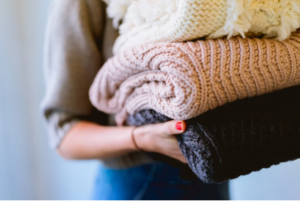
3. Is Crochet Stronger Than Knitting?
The age-old battle of the yarns – is crochet the sturdy knight or the delicate damsel in distress compared to knitting? Well, the answer, like a well-made scarf, is multifaceted!
Both knitting and crochet boast impressive strength, but in different ways. Knitting creates a fabric with interlocking loops, offering excellent stretch and resilience. Think sweaters that hug your curves without losing their shape. Crochet, on the other hand, uses interlocking posts, resulting in a denser, more stable fabric. Picture sturdy tote bags and cozy afghans that hold their ground.
So, who wins the strength crown? It depends on the battlefield!
For:
- Shape retention: Crochet, with its denser structure, excels at holding its form. Think structured hats or bags that stand tall.
- Durability: Crochet’s interlocking posts create a strong barrier against wear and tear, making it ideal for items like floor rugs or pet baskets.
- Heat resistance: Crochet fabrics typically hold their own against higher temperatures, making them suitable for pot holders or oven mitts.
But Knitting shines when it comes to:
- Stretch and flexibility: Knitting’s loop-based construction provides excellent elasticity, perfect for garments that need to move with you.
- Drape and fluidity: Knit fabrics tend to drape more gracefully, ideal for elegant shawls or flowing cardigans.
- Ease of repair: Repairing dropped stitches in knitting is often easier than fixing missed post stitches in crochet.
Ultimately, the “stronger” craft depends on the project’s needs. Embrace the unique strengths of each technique to create versatile and durable treasures that last.
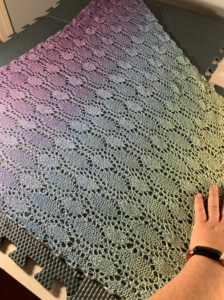
4. Should I Iron Crochet?
Ah, the iron – a tool for taming wrinkles and crisping collars. But when it comes to crochet, approaching this fiery friend requires a touch of caution. Before you reach for the steam, let’s explore the delicate dance between crochet and ironing:
The Case for Caution:
- Melting potential: Heat from an iron can easily melt or damage delicate yarns, especially synthetics. You wouldn’t want your meticulously crocheted masterpiece to turn into a gooey puddle, would you?
- Flattening the fun: The beauty of crochet often lies in its texture and dimension. Ironing can flatten those charming bumps and ridges, leaving your work stiff and lacking character.
- Shrinking possibilities: Some yarns, especially natural fibers, can shrink considerably under heat. Say goodbye to your perfectly sized afghan if you’re not careful!
But there’s hope for ironing enthusiasts!
In certain situations, a well-controlled iron can become your crochet ally:
- Blocking for precision: Dampening and gently shaping your finished piece with an iron can help it block into the desired form, especially for projects with intricate borders or curves.
- Removing stubborn creases: If your project develops a stubborn crease during storage or transport, a light touch with the iron on a low setting can help smoothen it out.
The key is to approach ironing with the utmost respect:
- Always test on a hidden scrap: Before touching your precious project, test the iron’s heat on a tiny piece of yarn from the same batch.
- Low heat is your friend: Stick to the lowest heat setting on your iron, and move it slowly and gently over the fabric.
- Never iron directly: Place a thin damp cloth between the iron and your crochet to avoid direct contact and heat damage.
- Embrace the natural charm: Remember, small imperfections and textural variations are what make crocheted pieces unique and beautiful. Don’t strive for ironed perfection – celebrate the inherent character of your craft!
So, should you iron crochet? The answer, like a beautifully crocheted scarf, depends on your needs and preferences. Be gentle, be cautious, and always test before you trust. With a mindful approach, the iron can become a helpful tool to enhance your crochet creations, but it’s never essential.

5. Is It Okay to Wash Crochet?
Absolutely! In fact, washing your crochet keeps it fresh, vibrant, and free from dust and grime. But fear not, gentle souls, your delicate creations won’t melt into soapy puddles if you follow these simple tips:
Embrace the Gentle Wash:
- Skip the spin cycle: That frantic whirling can tangle and stretch your precious stitches. Opt for a delicate cycle with minimal agitation.
- Cold comfort: Hot water can shrink or damage fibers. Stick to cold water to keep your work safe and vibrant.
- Mildly sudsy: Harsh detergents are like bullies to yarn. Choose a gentle wool or baby detergent to pamper your stitches.
- Mesh magic: Place your crochet in a mesh laundry bag to protect it from snags and tangles. It’s like a bubble bath for your beloved project!
The Art of Drying:
- Ditch the dryer: The high heat and tumbling can be disastrous for crochet. Air drying is your best friend.
- Flat is fantastic: Lay your crochet flat or hang it to dry away from direct sunlight, to prevent fading and stretching.
- Reshape with love: While damp, gently stretch and reshape your project back to its original form. Think of it as a spa treatment for your stitches!
Bonus Tips:
- Stain busters: For stubborn stains, pre-treat with a gentle stain remover before washing.
- Vinegar power: Add a splash of white vinegar to the rinse cycle to neutralize soap residue and keep colors bright.
- Regular dustings: A quick dust with a microfiber cloth between washes keeps your crochet looking its best.
Washing your crochet isn’t a chore, it’s a chance to show your creations some love and care! With these gentle techniques, your crocheted treasures will stay fresh, vibrant, and bring joy for years to come.
6. How Do You Shrink Crochet?
Ah, shrinkage – the bane of some crocheters, the secret weapon of others. While unwanted shrinkage can turn a perfectly sized sweater into a crop top, controlled shrinkage can be a powerful tool for crafting specific projects. So, how do you master this magic (or prevent it, depending on your goal)?
Shrinking Methods:
- Heat is king: Hot water and heat drying are the go-to methods for intentional shrinkage. Remember, heat shrinks most natural fibers like wool and cotton, so tread carefully with synthetics.
- Washing techniques: Opting for a hot wash cycle and skipping the spin can encourage some shrinkage. Be sure to test on a small swatch first to determine the desired amount.
- Felting frenzy: The ultimate form of shrinkage, felting transforms loose fabric into a dense, sturdy material. This technique requires special wool and specific washing techniques, so delve into it with caution and excitement!
Preventing Shrinkage:
- Cold comfort: Stick to cold water washing and drying to minimize shrinkage. Think of it as a refreshing ice bath for your stitches!
- Blocking magic: Blocking your finished project in its desired shape with cool water and gentle shaping pins can help prevent further shrinkage and maintain the right size.
- Yarn selection: Opt for yarns labeled “pre-shrunk” or choose synthetics that resist heat and moisture to ensure minimal size changes.
Remember, shrinkage is a powerful tool, but use it wisely! Test on swatches, be gentle with heat, and always prioritize project needs over dramatic transformations. Embrace the natural size and texture of your creations, or employ controlled shrinkage to achieve unique results.
7. How Do You Thicken Crochet?
Thin yarn got you feeling blue? Don’t fret, fellow crafters! There are ways to add some serious oomph to your projects and create cozy delights that feel like warm hugs. Here are some tricks to turn your yarn whispers into full-blown volume shouts:
Yarn Strategies:
- Double or triple the fun: Ditch the single strand and grab two or even three strands of your regular yarn! This instantly doubles or triples the thickness, creating delightfully chunky projects.
- Bulky buddies: Embrace the world of bulky and super bulky weight yarns. These giants of the yarn aisle pack a serious punch in terms of volume, and require just one strand to create impressive thickness.
- Texture transformations: Explore textured yarns, like slub or boucle, which have built-in bumps and loops that add instant dimension and thickness to your work.
Stitch Savvy:
- Say yes to puff! Embrace stitches like puff stitch, popcorn stitch, and bobble stitch. These delightful variations create raised bumps and pops of texture, adding significant thickness to your fabric.
- Cluster power: Cluster stitches group multiple regular stitches together, resulting in thicker, denser blocks of fabric. They’re perfect for blankets, bags, and anything that needs a hefty dose of cozy.
- Work big, go bold: Experiment with larger hook sizes than recommended for your yarn. This creates looser stitches and a thicker overall fabric.
Remember, thickening also comes with adjustments:
- Gauge watch: As your yarn weight or stitch choice changes, gauge (the number of stitches per inch) will be affected. Make sure to swatch and adjust your pattern if needed.
- Pattern modifications: Some patterns might need slight adjustments for thicker yarns. Pay attention to stitch counts and adjust row repeats or decreases to ensure your project comes out just right.
So, embrace the thickness, fellow yarn enthusiasts! With a little creativity and these handy tips, you can transform your delicate threads into delightfully chunky wonders that bring warmth and joy to your home and wardrobe.
8. How Do You Starch Crochet?
Ah, starch – the silent guardian of crisp collars and structured garments. But can this magical liquid work its wonders on the world of crochet? Absolutely! Starch can be a powerful tool for adding a touch of firmness, definition, and even elegance to your crocheted projects.
Starching Strategies:
- Choose your weapon: Opt for a spray starch specifically designed for delicate fabrics like wool or cotton. Avoid harsh starches meant for heavy linens, as they can stiffen your yarn too much.
- Testing, testing: Always, always test any starch mixture on a small, inconspicuous area of your project first. This helps avoid unwanted surprises and potential damage.
- Spray with care: Hold the starch can at least 6 inches away from your work and apply light, even sprays. Too much starch can make your project stiff and unnatural.
- Shape and dry: While the starch is still damp, gently reshape your project into the desired form. Lay it flat or hang it to dry, away from direct sunlight and heat.
The magic of starch for crochet:
- Crisp edges: Starch can help define and stiffen edges, particularly useful for collars, cuffs, or doilies. Think perfectly starched tablecloths and collars that stand tall with pride!
- Structured shapes: For projects like baskets or tote bags, starch can add much-needed stability and help them hold their form.
- Enhanced details: Intricate stitches and textured patterns can be accentuated with a light starch, highlighting their beauty and definition.
But remember, a little starch goes a long way:
- Keep it light: Over-starching can make your project stiff and uncomfortable. Aim for a subtle enhancement, not a full-blown board game piece!
- Not for everything: Some delicate yarns and projects might not react well to starch. Use your judgment and test before you commit.
- Wash with care: Starched projects might require special washing and drying instructions. Check the starch label and adjust your cleaning routine accordingly.
So, embrace the potential of starch, but wield it with a gentle hand! By understanding its power and using it thoughtfully, you can add a touch of sophistication and structure to your crochet creations, making them truly stand out.

